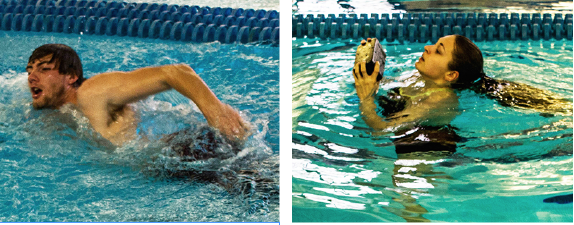Partakers get choices in the challenge

Left: Senior Aquatics Communications Coordinator Ben Pick attempts to complete one of the aquatic challenges. Right: Junior Alex Popovich treads water holding a 10-pound brick out of water.
November 9, 2016
Pitt-Johnstown students, faculty and staff members can dive into the Zamias Aquatic Center pool to complete aquatic challenges until Nov. 17 and win a T-shirt.
According to Aquatic Coordinator James Hedrick, the first aquatic challenges were in 2008, and have been offered about once per academic year since then.
According to Hedrick, the event is primarily for students, but some faculty and staff have participated.
Coupons for a free pizza have been offered as a prize in the past, according to Hedrick.
Hedrick said the funds for prizes are drawn from the Zamias Aquatic Center donated funds.
This year, participants are required to complete one of three short challenges and one of two long challenges to win a prize.
According to a flier, the three short challenges are treading water while holding a brick out of the water, swimming while towing a brick across the pool and retrieving a dummy from the bottom of the pool’s deep end within specified time limits and swimming distances.
The two long challenges are completing The Cooper Swim Test in the good category and treading water and swimming fully clothed within specified time limits and swimming distances.
The Cooper Swim Test, according to Aquatics Communications Coordinator Ben Pick, is a 12-minute swim test that, depending on age, gender and distance, determines a person’s fitness category.
“There are five fitness categories: excellent, good, fair, poor, and very poor,” Pick said.
“So, for example, if you are a male in the age range of 20 to 29 years-old, and swam 700 to 799 yards in 12 minutes, you would fall into the (good category). A female in the same age range who swam 600 to 699 yards in 12 minutes would also fall into the (good category).”
Pick said his role is to market the event, discuss with Hedrick and other aquatic staff members what swimming challenges are fair to students, yet challenging enough to be awarded a T-shirt, and monitoring those who are attempting to complete them.
“We decided to give (participants) choices because some (participants) are better at certain challenges than others, giving everyone a more equal chance of completing the challenges for the T-shirt,” Pick said.
“This is the first year that we have actually given students the choice of challenges, so we will see what the most popular choice of challenges are after the event.”
Participation in the challenges is encouraged by Zamias Aquatic Center staff members because, according to Pick, it is good fun and differs from the usual on-campus events offered.
Fliers have been distributed on campus to market the event, and Aquatic staff members also are attempting to get a campus-wide email sent to all students, Pick said.
“We also want to make people more aware of the pool here at (Pitt-Johnstown) because we feel that there are still many students on campus who don’t even know that we have a pool,” Pick said.
“The challenges do not seem (to have) generated much interest in (signing up for) aquatic classes in the past, and it is not a primary goal, but if interest is generated by trying the challenges, then that is an added benefit.”
Junior Marshall Kuhn said he participated in the aquatic challenges last year.
“(The only challenge) was to simulate a boat sinking while out at sea; one had to tread water in full dress, including shoes, for 15 or 20 minutes, and then swim … 10 laps ‘back to shore.’”
Kuhn said he passed the challenge, and received a T-shirt as a prize.
He also said he is planning to participate in the aquatic challenges this year.
There are four aspects that should encourage others to participate, Kuhn said.
“If you enjoy swimming, they’re fun, it’s great exercise, you get to better know what you are capable of and, if you haven’t considered aquatic conditioning as an alternative to traditional exercise, this could be a good opportunity to see what you think.”
There is no cost or need to sign up for the challenges. Participants may come to the Zamias center during time slots listed on the flier and tell a staff member that they want to attempt the challenges. A participant may attempt the challenges multiple times.
“The time slots are determined by the times that I am working, and others who are very familiar with the challenges are working … to judge the participants,” Pick said.
Hedrick said the challenges are supervised by certified lifeguards.
According to the flier, students can attempt the challenges between 6:30 and 9 p.m. Mondays, between 11 a.m. and 12:45 p.m. Tuesdays, between 4 and 5 p.m. and 8 and 9 p.m. Wednesdays, as well as between 11 a.m. and 12:45 p.m. and between 5 and 9 p.m. Thursdays.

